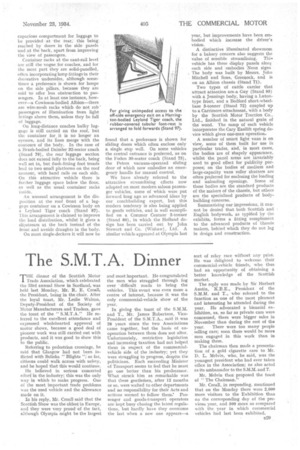The S.M.T.A. Dinner
Page 43

If you've noticed an error in this article please click here to report it so we can fix it.
THE dinner of the Scottish Motor Trade Association, which celebrated the 33rd annual Show in Scotland, was held last Monday, Mr. R. E. Groan, the President, being in the chair. After the loyal toast, Mr. Leslie Walton, Deputy-President of the Society of Motor Manufacturers and Traders, gave the toast of the " S.M.T.A." He re-ferred to the excellent attendance and
expressed wholehearted approval of motor shows, because a good deal of pioneer work was still carried out with products, and it was good to show this to the public.
Referring to pedestrian crossings, he said that Glasgow had not been inflicted with Belisha "Blights" so far, citizens could walk across with safety, and he hoped that this would continue.
He believed in serious concerted effort in the industry; this was the only way in which to make progress. One of the most important trade problems as the used vehicle and the allowance made on it.
In his reply, Mr. Croall said that the Scottish Show was the oldest in Europe, and they were very proud of the fact, although Olympia might be the largest and most important. He congratulated the men who struggled through fog over 'difficult roads to bring the vehicles. This event was even more a centre of interest, because it was the only commercial-vehicle show of the year.
In giving the toast of the S.M.M. and T., Mr. James Robertson, VicePresident of the S.M.T.A., said it was 28 years 'since the two Associations came together, but the basis of cooperation between them does not alter. Unfortunately, restrictive legislation and increasing taxation had not helped them in respect of the commercialvehicle side of the industry; yet they were struggling to progress, despite the politicians. Each succeeding Minister of Transport seems to feel that he must go one better than his predecessor. What struck him as remarkable was that these gentleMen, after 12 months or so, were wafted to other departments and no responsibility for their Acts and actions seemed to follow them.' Passenger and goods-transport operators are kept busy chasing the latest regulations, but hardly have they overcome the last when a new one appears—a sort of relay race without any prize. He was delighted to welcome their commercial-vehicle friends, who thus had an opportunity of obtaining a better knowledge of the Scottish market.
The reply was made by Sir Herbert Austin, K.B.E., President of the S.M.M. and T,, who referred to the function as one of the most pleasant and interesting he attended during the year. He advocated a biennial exhibition, as, so far as private cars were concerned, there were bigger sales in November than during the rest of the year. There were too many people selling cars; soon them would be more men engaged in this work than in making them.
The chairman then made a presentation of a gold cigarette case to Mr. D. L. Melvin, who, he said, was the youngest president who had ever taken office in the Association; he also acted as its ambassador to the S.M.M. and T.
Mr. Melvin then proposed the toast of "The Chairman."
Mr. Groan, in responding, mentioned that on the Monday there were 2,000 more visitors to the Exhibition than on the corresponding day of the previous year, and 500 more as compared with the year in which commercial vehicles had last been exhibited.




























































































